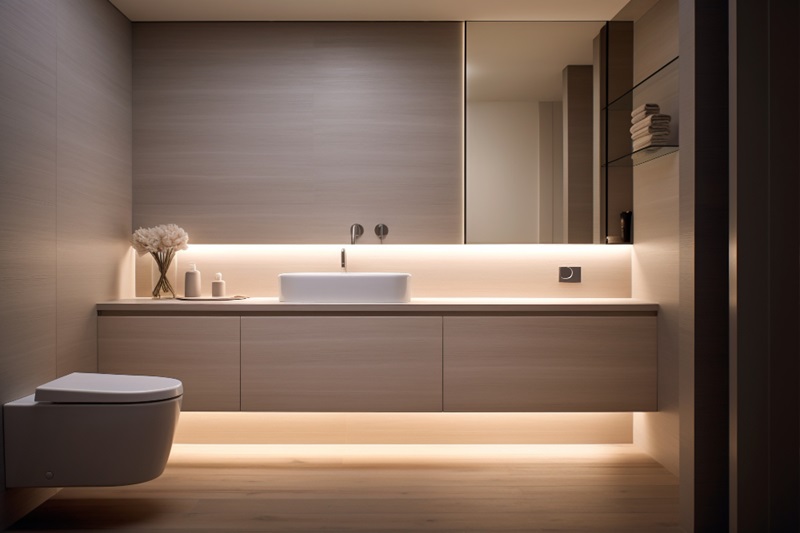Bathroom cabinets are an essential element in any bathroom, providing both functionality and aesthetic appeal. Whether you’re remodeling your bathroom or simply looking to enhance your storage space, selecting the right bathroom cabinet can make a significant difference. In this guide, we will explore various styles, materials, and installation tips to help you choose the perfect bathroom cabinets for your home.
Types of Bathroom Cabinets
1. Wall-Mounted Cabinets
Wall-mounted cabinets are perfect for small bathrooms as they do not take up floor space. These cabinets are attached to the wall, offering convenient storage for toiletries, towels, and other essentials. They come in various sizes and styles, making them a versatile option for different bathroom layouts.
2. Freestanding Cabinets
Freestanding cabinets offer flexibility in placement and come in a variety of designs, including traditional, contemporary, and rustic styles. These cabinets can be placed against any wall, making them an ideal choice for larger bathrooms that require additional storage space.
3. Medicine Cabinets
Medicine cabinets are typically mounted above the sink or vanity, providing easy access to everyday essentials such as medications, skincare products, and grooming items. Some models come with mirrored doors, adding functionality by doubling as a vanity mirror.
4. Under-Sink Cabinets
Under-sink cabinets maximize the space beneath your sink, helping to conceal plumbing while offering storage for cleaning supplies and toiletries. These cabinets are available in different configurations, including single and double-door options.
5. Linen Cabinets
Linen cabinets are tall, narrow storage units designed to store towels, washcloths, and other bathroom linens. They are perfect for keeping your bathroom organized and clutter-free.
Choosing the Right Material for Bathroom Cabinets
The material of your bathroom cabinets plays a crucial role in their durability and aesthetics. Here are some common materials to consider:
1. Solid Wood
Solid wood cabinets offer a classic and high-end look. They are durable but may require regular maintenance to prevent warping due to humidity exposure. Hardwoods like oak, maple, and cherry are popular choices.
2. Plywood
Plywood is a strong and moisture-resistant alternative to solid wood. It consists of multiple layers of wood veneer, making it a sturdy and long-lasting option for bathroom cabinetry.
3. MDF (Medium-Density Fiberboard)
MDF is an affordable and smooth material that is often used in painted bathroom cabinets. While it is resistant to cracking and peeling, it may not be as moisture-resistant as other options unless properly sealed.
4. Thermofoil
Thermofoil cabinets are made from MDF wrapped in a plastic coating. They are highly resistant to moisture and easy to clean, making them an excellent choice for bathrooms.
5. Metal and Glass
For a sleek and modern look, metal and glass cabinets are great options. Stainless steel cabinets are highly durable and resistant to rust, while glass cabinets add an elegant touch and can be used for decorative storage.
Installation Tips for Bathroom Cabinets
Installing bathroom cabinets requires careful planning to ensure they fit properly and serve their purpose efficiently. Here are some essential tips:
1. Measure Your Space
Before purchasing cabinets, measure your bathroom space to determine the dimensions that will fit best. Consider the height, width, and depth of the cabinets to avoid overcrowding the room.
2. Choose the Right Placement
Decide on the placement of your cabinets based on functionality and accessibility. Wall-mounted cabinets should be installed at a convenient height, while freestanding cabinets should be positioned where they do not obstruct movement.
3. Secure Properly to Walls
For wall-mounted cabinets, use appropriate anchors and screws to ensure they are securely attached to wall studs. This will prevent accidents and ensure long-term stability.
4. Consider Ventilation
Since bathrooms are high-humidity areas, proper ventilation is essential to prevent mold and mildew buildup. Ensure there is adequate airflow around the cabinets, and avoid placing them too close to showers or bathtubs.
5. Professional Installation vs. DIY
If you have experience with carpentry and home improvement projects, installing bathroom cabinets can be a DIY task. However, for complex installations or customized cabinetry, hiring a professional can ensure precision and quality craftsmanship.
Maintaining Your Bathroom Cabinets
To extend the lifespan of your bathroom cabinets, regular maintenance is essential. Here are some maintenance tips:
1. Clean Regularly
Wipe down cabinets with a damp cloth to remove dust, soap scum, and water stains. Avoid using harsh chemicals that may damage the finish.
2. Prevent Water Damage
Use mats or trays inside cabinets to catch leaks or spills. Ensure your bathroom is well-ventilated to prevent moisture accumulation.
3. Check for Loose Hinges and Handles
Over time, hinges and handles may become loose. Regularly inspect and tighten them to keep your cabinets in good condition.
4. Repaint or Refinish as Needed
If your cabinets show signs of wear, consider repainting or refinishing them to refresh their look. Choose water-resistant paints or finishes suitable for bathrooms.
Conclusion
Bathroom cabinets are more than just storage solutions; they enhance the functionality and aesthetics of your bathroom. By choosing the right style, material, and installation method, you can create a well-organized and visually appealing space. Whether you opt for a modern, traditional, or rustic look, investing in high-quality bathroom cabinets will improve your bathroom’s overall appeal and usability for years to come.







